Sold Ceramics
Sold Japanese Tea, Coffee and Chocolate wares 18th Century
Page 2
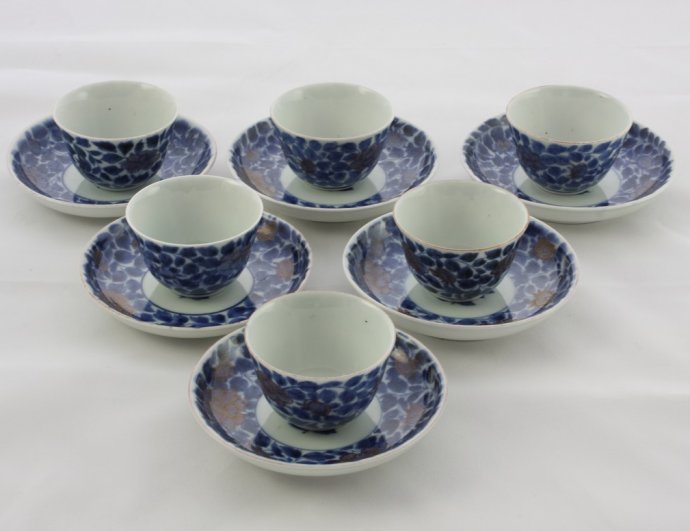
Sold Ceramics - Sold Japanese Tea, Coffee and Chocolate wares 18th Century - Page 2
Objects 2011624A/F
Six teacups and saucers
Japan
c.1700
Height of teacups 41 mm (1.61 inch), diameter of rims 65 mm (2.56 inch), diameter of footrings 29 mm (1.14 inch), weights 83/86/100/103/105/108 grams (2.93/3.03/3.53/3.63/3.70/3.81 ounce (oz.))
Height of saucers 25 mm (0.98 inch), diameter of rims 115 mm (4.53 inch), diameter of footrings 65 mm or (2.56 inch), weights 44/46/47/48/49/53 grams (1.55/1.62/1.65/1.69/1.73/1.87 ounce (oz.))
Six teacups and saucers on footrings, flared straight sides and slightly everted rims. Decorated in underglaze blue and overglaze gold. On the saucers a single flowering peony spray in a central roundel surrounded by dense leafy peony scrolls with three large flower heads. The reverses are undecorated. On the outsides of the teacups dense leafy scrolls with three large peony flower heads. On the bottoms a single flowering peony spray.
Teacups and saucers were especially developed for export, as Chinese and Japanese teacups did not have saucers. They were probably inspired by earlier Turkish and Islamic examples. VOC- records show that the Japanese made cups and matching saucers from the very beginning of the export trade.
Jörg mentions that there are very few examples in Dutch collections of Arita tea wares in underglaze blue, they are quite rare. One of the reasons probably is that Japanese potters couldn’t compete with the much cheaper Chinese tea wares.
One of the best known examples of Japanese Arita tea ware are the teacups and saucers decorated with the coat of arms of the Dutch family Huydecoper. Another equally rare set of teacups and saucers, with a more stylized decoration of scrolling vine with birds, is in the collection at the Japanese replica of Huis Ten Bosch, near Nagasaki, dated 1670-90. More interesting for comparison however are some tea cups found during excavations in Amsterdam, dated 1660-80, with an identical decoration. The later date of c.1700 of our set is mainly based on the clear inspiration by later Chinese Kangxi flower scrolls. (Arita 2000, p.57 cat. 87), (Jörg 2003/1, pp.191-192 & p.231, cat. 293).
For Arita teacups and saucers decorated in underglaze blue with identical decoration, please see:
For other Arita teacups and saucers decorated in underglaze blue, please see:
- Japans porselein met blauwe decoraties uit de tweede helft van de zeventiende en de eerste helft van de achttiende eeuw. (D.F. Lunsingh Scheurleer in Mededelingenblad Nederlandse Vereniging van Vrienden van de Ceramiek, vols. 64/65, 1971), p.114, cat. 190.
- Fine & Curious: Japanese Export Porcelain in Dutch Collections, (C.J.A. Jörg, Hotei Publishing, Amsterdam 2003), p.231 cat.293.
- The Voyage of Old-Imari Porcelains: Exhibition Catalogue of the Kyushu Ceramic Museum, Arita, p.57, cat.87.
Condition:
Teacups: One with a fleabite to the footring and one with a hairline to the rim, the other four are in perfect
Saucers: All six perfect.
References:
Lunsingh Scheurleer 1971, cat. 190
Arita 2000, p.57, cat. 87, p.122, cat. 252 & 253 & pp.212-213, cat. 16a/b
Price: Sold.

Sold Ceramics - Sold Japanese Tea, Coffee and Chocolate wares 18th Century - Page 2
Object 20101
Teacup and saucer
Japan
1700-1720
Height of teacup 44 mm (1.73 inch), diameter of rim 74 mm (2.91 inch), diameter of footring 35 mm (1.38 inch), weight 40 grams (1.41 ounce (oz.))
Height of saucer 26 mm (1.02 inch), diameter of rim 120 mm (4.72 inch), diameter of footring 64 mm or (2.52 inch), weight 93 grams (3.28 ounce (oz.))
Teacup and saucer on footrings, slightly everted rims. Imari decorated in underglaze blue with iron-red, and gold with four carps leaping out of a turbulent sea with clouds the sun and two birds in flight. On the sides a border with carps alternating with birds in flight, Around the rim flowering prunus sprays and florets between scrolls. On the reverse two flowering prunus sprays and three concentric bands aound the footring. On the base an old paper collectors label that reads: 'nr 51'. The teacup is decorated en suite.
This leaping carp design was copied from late Chinese Ming objects many times during the 17th century but it is rare on 18th and late 18th century objects. (Finch 1998, p.20, cat. 108)
For a smilarly decorated later 18th century saucer/dish, please see:
Condition: Both perfect.
Reference:
Price: Sold.
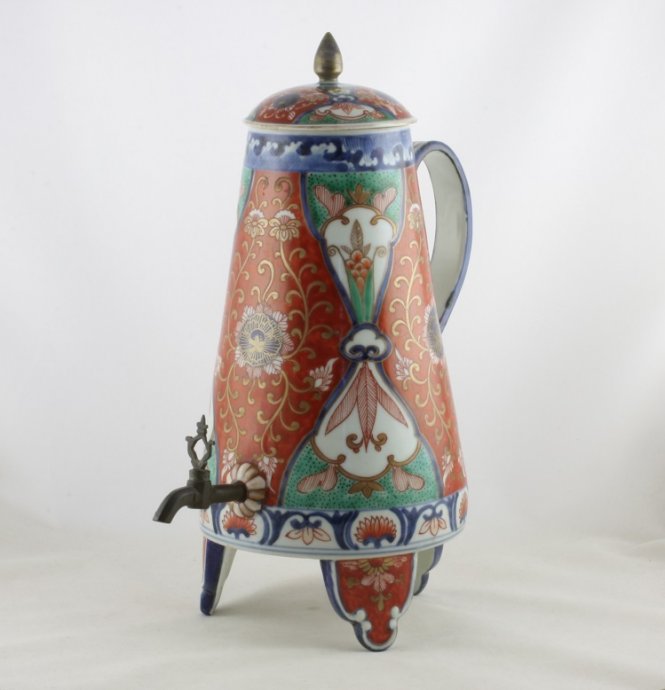
Sold Ceramics - Sold Japanese Tea, Coffee and Chocolate wares 18th Century - Page 2
Object 2012169
Coffee pot
Japan
1700-1720
Height with cover 345 mm (13.58 inch), height without cover 291 mm (11.46 inch), diameter handle to spout 265 mm (10.43 inch), diameter of mouthrim 83 mm (3.27 inch), diameter of footring 154 mm (6.06 inch), weight with cover 1,834 grams (64.69 ounce (oz.)), weight cover 160 grams (5.64 ounce (oz.))
Coffee pot of conical shape on three flat modelled feet. Curved, flat pierced handle, domed cover with pointed knob and loop ring (intended for a chain between the top of the handle and the loop ring on the cover). The hole for the mounted Dutch brass tap in the lower part is surrounded by a kiku-flower modelled in low relief. Kenjo-Imari, decorated in underglaze blue, iron-red, green and gold. Six shaped panels outlined in underglaze blue and filled with foled leaves or a stylised, symmetrical flowering plant. In between on an iron-red ground a stylised flower head in underglaze blue and stylised leaves and flowers in gold. Round the foot a border with flower heads and scrolls and round the rim a border with waves and clouds. On the handle and feet stylised scrolls with leaves and flowers. The cover is decorated en suite.
As was the case with tea, it was not until the end of the 17th century that drinking coffee became popular in Europe. each town had his own coffee house, where everyone - which in fact meant mainly men - could enjoy drinking a cup of coffee. The Dutch East India Company, (Vereenigde Oost-Indische Compagnie, VOC), started off mainly importing coffee from Yemen, experimenting only later with plantations of their own in Java.
However, drinking coffee had for centuries already been a common practice in the Middle East. European coffee pots were therefore often modelled after Islamic copper examples. Two types of coffee pots were most frequently commissioned in Asian porcelain: conical and belly-shaped. The conical shaped pot originally came from Japan. After brewed coffee was poured into this luxurious porcelain pot, it was held warm on a stand and subsequently served through a metal tap which had later been added to the pot after it had been imported to the Netherlands. At the bottom of the pot the coffee grounds were collected. Coffee pots from China, where both types were made, don't feature a tap but a spout. (The World at Home, exhibition Groninger Museum 17 june 2017 - 31 march 2019)
A distinctive style of formally-painted, almost Baroque-looking pieces with broad areas of strong, dark enemal is referred to in Japan as kenjo-Imari ('presentation-Imari'). (Ayers, Impey & Mallet 1990, p.211)
Coffee pots, usually three-legged, are common in blue-and-white and in enamelled Imari. usually there is one hole left for a tap to be fitted in Europe, occasionally there are three. (Ayers, Impey & Mallet 1990, p.213)
For an identically shaped, sized and decorated Coffee pot, please see;
Condition: A chip to the rim and restored cover and feet.
References:
Ayers, Impey & Mallet 1990, p.211 & p.213
Price: Sold.

Sold Ceramics - Sold Japanese Tea, Coffee and Chocolate wares 18th Century - Page 2
Object 2012195
Teapot
Japan
1700-1720
Height with cover 105 mm (4.13 inch), height without cover 67 mm (2.64 inch), diameter handle to spout 150 mm (5.91 inch), diameter of mouthrim 50 mm (1.97 inch), diameter of footring 55 mm (2.17 inch), weight with cover 224 grams (7.90 ounce (oz.)), weight cover 57 grams (2.01 ounce (oz.))
Globular pear-shaped teapot, fluted body. Curved handle and a straight spout. Ribbed cover. Fitted with Dutch silver mounts (knob of cover and spout). Decorated in iron-red and gold. Reserved on the red ground stylised scrolls with leaves and flowers in gold and two kidney-shaped medallions each filled with a riverscape. On the handle and spout stylised leafy scrolls in gold. The cover is decorated en suite.
For identically decorated teacups and saucers, probably belonging to the same tea ervice as this teapot, please see:
-
Japanese Tea, Coffee and Chocolate wares 18th Century - Page 2 - Object 2012068.
- Sold Ceramics - Sold Japanese Tea, Coffee and Chocolate wares 18th Century - Page 2 - Object 2011921.
For similarly decorated coffee pots, please see:
- Porzellan aus China und Japan. Die Porzellangalerie der Landgrafen von Hessen-Kassel, (Staatliche Kunstsammlungen Kassel, Berlin 1990), p.531, cat. 292.
- The Voyage of Old-Imari Porcelains: Exhibition Catalogue of the Kyushu Ceramic Museum, Arita 2000, p.61, cat. 98.
- Fine & Curious. Japanese Export Porcelain in Dutch Collections, (C.J.A. Jörg, Hotei Publishing, Amsterdam, 2003), p.292, cat. 292.
Condition : Perfect.
References:
Price: Sold.

Sold Ceramics - Sold Japanese Tea, Coffee and Chocolate wares 18th Century - Page 2
Object 2012068
Teacup & saucer
Japan
1700-1730
Height of teacup 41 mm (1.61 inch), diameter of rim 83 mm (3.27 inch), diameter of footring 33 mm (1.30 inch), weight 62 grams (2.19 ounce (oz.))
Height of saucer 26 mm (1.02 inch), diameter of rim 135 mm (5.31 inch), diameter of footring 69 mm or (2.72 inch), weight 124 grams (4.37 ounce (oz.))
Teacup and saucer on footring, spreading sides. Decorated in iron-red and gold with a central roundel filled with a flower spray. On the sides and rim, reserved on the red ground, stylised scrolls with leaves, flowers and two two kidney-shaped medallions each filled with a riverscape. On the reverse four flower sprays. The teacup is decorated en suite.
For a smaller sized, identically shaped and decorated teacup & saucer, please see:
For similarly decorated coffee pots, please see:
- Porzellan aus China und Japan. Die Porzellangalerie der Landgrafen von Hessen-Kassel, (Staatliche Kunstsammlungen Kassel, Berlin 1990), p.531, cat. 292.
- Fine & Curious. Japanese Export Porcelain in Dutch Collections, (C.J.A. Jörg, Hotei Publishing, Amsterdam, 2003), p.292, cat. 292.
Condition :
Teacup: A firing flaw to the inner footring and a fleabite to the rim.
Saucer: A chip to the inner footring.
References:
Price: Sold.
More pictures of object 2011921, a smaller identically shaped and decorated teacup and saucer >>
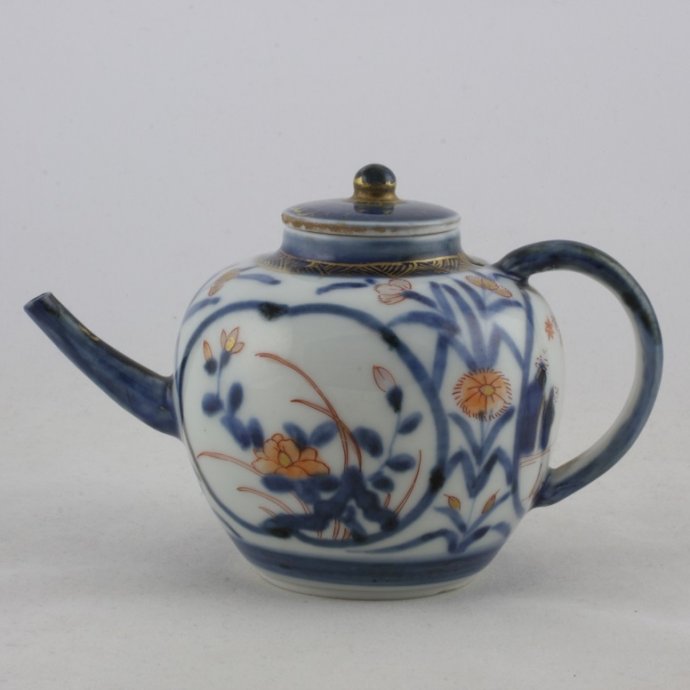
Sold Ceramics - Sold Japanese Tea, Coffee and Chocolate wares 18th Century - Page 2
Object 2011367
Teapot
Japan
1700-1720
Height with cover 84 mm (3.31 inch), height without cover 70 mm (2.76 inch), diameter handle to spout 125 mm (4.92 inch), diameter of mouthrim 31 mm (1.22 inch), diameter of foot 44 mm (1.73 inch), weight with cover 120 grams (4.23 ounce (oz.)), weight cover 11 grams (0.39 ounce (oz.))
Globular teapot on circular flat unglazed base, curved handle, slightly bent spout. Flat cover with round knob. Imari decorated in underglaze blue, iron-red and gold with three kidney-shaped panels, two filled with flowering plants and a bird in flight and one with a river scape. In between the panels flower sprays. Round the foot a silk worm-pattern border in gold on an underglaze blue ground. On the pierced shoulder a zig-zag lines-pattern border in gold on an underglaze blue ground. and on the cover a chrysanthemum flower head outlined in gold on an underglaze blue ground. The cover is decorated en suite.
Condition: A horizontal firing tension glaze hairline, caused during the firing process, just onder the handle and a tiny restored spot to the tip of the spout
Price: Sold.
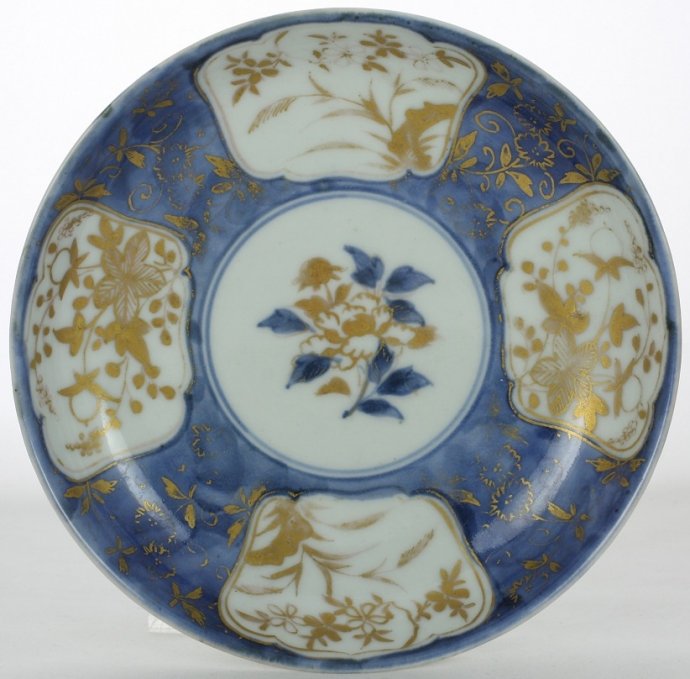
Sold Ceramics - Sold Japanese Tea, Coffee and Chocolate wares 18th Century - Page 2
Object 2010685
Saucer
Japan
1700-1720
Height 29 mm (1.14 inch), diameter of rim 151 mm (5.94 inch), diameter of footring 78 mm (3.07 inch), weight 198 grams (6.98 ounce (oz.))
Saucer on footring, straight rime. Imari decorated in underglaze blue and overglaze gold with a central roundel filled with a flowering chrysanthemum. On the sides four scalloped cartouches filled with various flowering plants reserved on an underglaze blue ground with foliate scrolls in gold. The reverse is undecorated.
This saucer was probably originally, as a stand, part of a chocolate set together with a matching covered beaker now missing.
Condition : Perfect with little wear to the golden decoration.
Price: Sold.

Sold Ceramics - Sold Japanese Tea, Coffee and Chocolate wares 18th Century - Page 2
Object 2010303
Teapot
Japan
1700-1720
Height with cover 105 mm (4.13 inch), height without cover 67 mm (2.64 inch), diameter handle to spout 150 mm (5.91 inch), diameter of mouthrim 50 mm (1.97 inch), diameter of footring 55 mm (2.17 inch), weight with cover 224 grams (7.90 ounce (oz.)), weight cover 57 grams (2.01 ounce (oz.))
Globular pear-shaped teapot on footring, fluted body. Curved handle and a straight spout. Ribbed cover and knob. Imari decorated in underglaze blue, iron-red and gold on both sides with flowering plants and leafy scrolls. On the handle a floret between scrolls and on the spout two flowering stems. The cover is decorated en suite.
Condition: A shallow, tiny and very light rough spot to the top of the spout and a firing flaw to the underside of the finial.
Price: Sold.
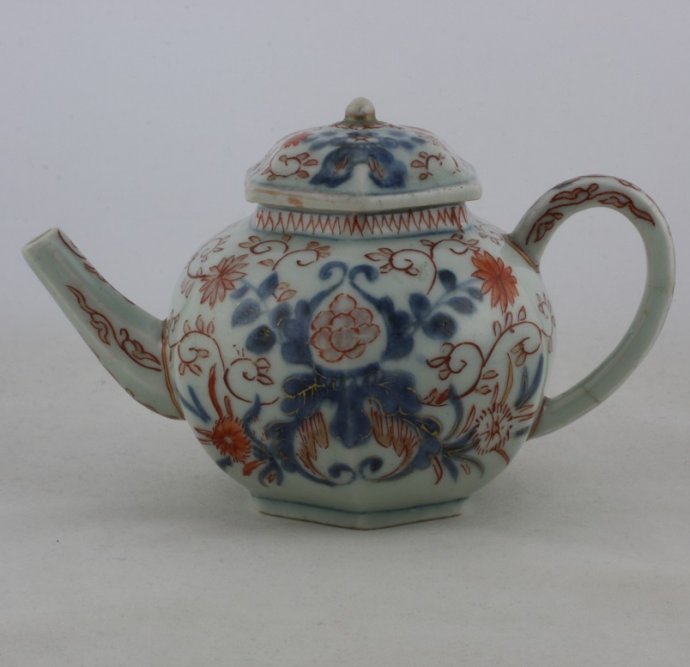
Sold Ceramics - Sold Japanese Tea, Coffee and Chocolate wares 18th Century - Page 2
Object 2010770
Teapot
Japan
1700-1720
Height with cover 102 mm (4.02 inch), height without cover 77 mm (3.03 inch), diameter handle to spout 162 mm (6.38 inch), diameter of mouthrim 42 mm (1.65 inch), diameter of footring 43 mm (1.69 inch), weight with cover 246 grams (8.68 ounce (oz.)), weight cover 37 grams (1.31 ounce (oz.))
Octagonal teapot of globular shape on octagonal footring, slightly bent spout, curved handle, domed cover. Greyish paste and greenish glaze. Imari decorated in underglaze blue, iron-red and gold with trailing floral sprays covering the whole body and cover. On the handle and spout florets and scrolls.
In the first half of the seventeenth century tea was imported to Europe as were Yixing stoneware and blanc de Chine porcelain from China. The Dutch East India Company, (Vereenigde Oost-Indische Compagnie, VOC) specially ordered blue and white porcelain pots from Jingdezhen beginning in 1639, and continued their orders when trade shifted to Japan. This teapot, decorated in the usual Imari palette with flowers and foliage, is a good example of this shifted trade. (Rotondo-McCord 1997, p.101)
For an identically shaped, sized and decorated teapot, please see;
Condition: A firing flaw to the inside wall of the teapot and a restored handle (broken at four places).
Reference:
Price: Sold.
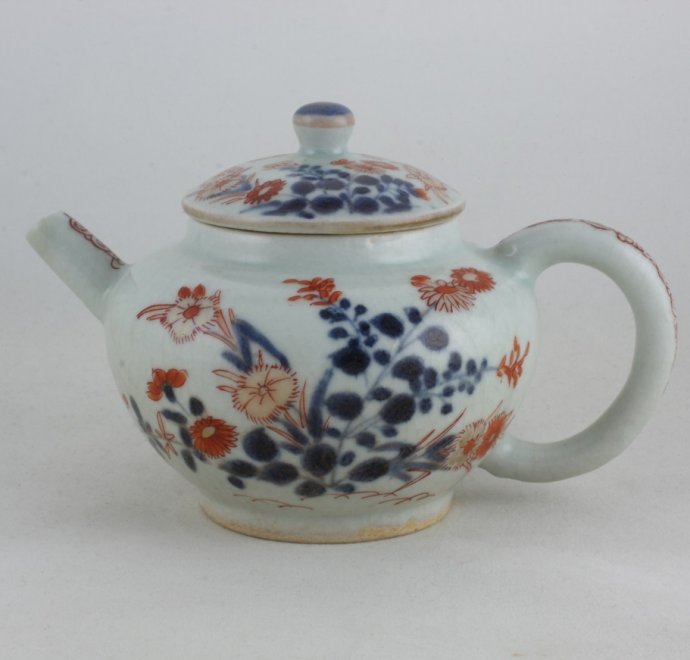
Sold Ceramics - Sold Japanese Tea, Coffee and Chocolate wares 18th Century - Page 2
Object 2010796
Teapot
Japan
1700-1720
Height 86 mm (3.39 inch), diameter handle to spout 137 mm (5.39 inch), diameter of mouthrim 48 mm (1.89 inch), diameter of footring 48 mm (1.89 inch), weight with cover 214 grams (7.55 ounce (oz.)), weight cover 36 grams (1.27 ounce (oz.))
Teapot on footring, curved handle, straight spout. Flat cover with round knob. Imari decorated in underglaze blue, iron-red and gold with on each side groups of various flowering plants. On the handle and spout florets between scrolls. The cover is decorated en suite.
Condition: A restored spots to the tip of the spout and the underside of the handle.
Price: Sold.
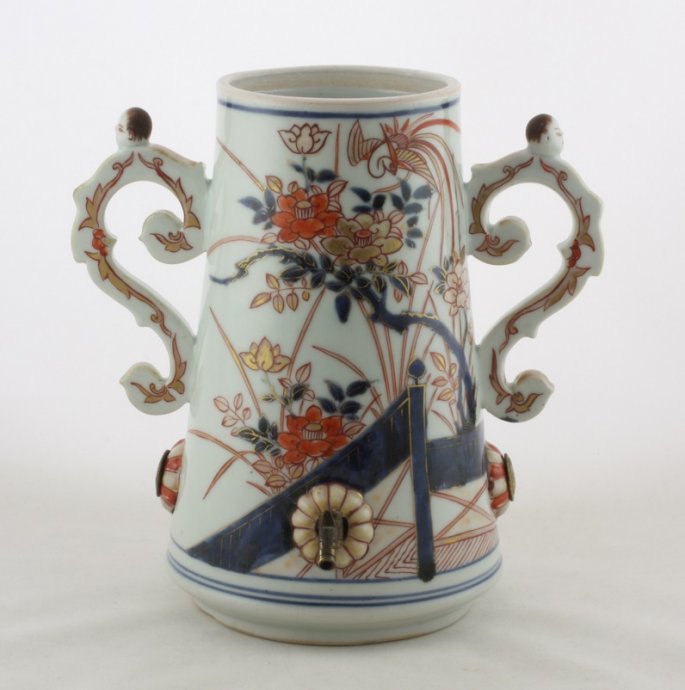
Sold Ceramics - Sold Japanese Tea, Coffee and Chocolate wares 18th Century - Page 2
Object 2011915
Coffee pot
Japan
1700-1730
Height 214 mm (8.43 inch), diameter of mouthrim 85 mm (3.35 inch), diameter of footring 105 mm (4.13 inch), weight 1,295 grams (45.68 ounce (oz.)).
Tapering cylindrical coffee pot on footring. The original cover is missing, a hole to the base. Two karakusa (spiky lotus) shaped side-handles with thumb-rests in the shape of a human head. The three holes in the lower part pf the body, the one on the front with a bronze tap the other two beneath the handles with a bronze rosette, are surrounded by a kiku-flower modelled in low relief. Imari decorated in underglaze blue, iron-red and gold on both sides with a fenced terrace with flowering plants, trees and a phoenix in flight. Scrollwork on the handles.
Like tea, coffee was first regarded as a medicinal drug: similarly it suddenly became a popular beverage at the end of the 17th century. Coffee houses were opened all over Europe and, whereas drinking tea was mainly a womanly pursuit, coffee houses were almost exclusively frequented by men.
Apparently, coffee pots with spouts, well known in Chinese export porcelain, were not made in Arita. A specifically Dutch and rather rare shape is the coffee urn with two elegant curving side-handles and/or three taps. These metal taps were later added in Europe, in spaces left for the purpose. Jörg mentions that no examples of the three tap type coffee can seem to be represented in public collections in the Netherlands. (Ford/Impey 1989, p. 90), (Jörg 2003/1, pp. 192-193)
For a coffee pot with identical form and handles with human heads, please see:
- Porzellan aus China und Japan. Die Porzellangalerie der Landgrafen von Hessen-Kassel, (Staatliche Kunstsammlungen Kassel, Berlin 1990), p.530, cat. 290.
- Imari. Porcelain for European Palaces from the Freda and Ralph Lupin Collection. (L. Rotondo-McCord & P.J. Bufton, New Orleans Museum of Art, New Orleans 1997), p.105, cat. 85 .
- The Voyage of Old-Imari Porcelains: Exhibition Catalogue of the Kyushu Ceramic Museum, Arita 2000, p.62, cat.99.
- http://saga-museum.jp/ceramic/exhibition/collection/kanbara/000563.html
For an identically shaped coffee pot on three legs, please see:
Condition: A frit to the rim and a hole in the base.
References:
http://saga-museum.jp/ceramic/exhibition/collection/kanbara/000563.html
Price: Sold.
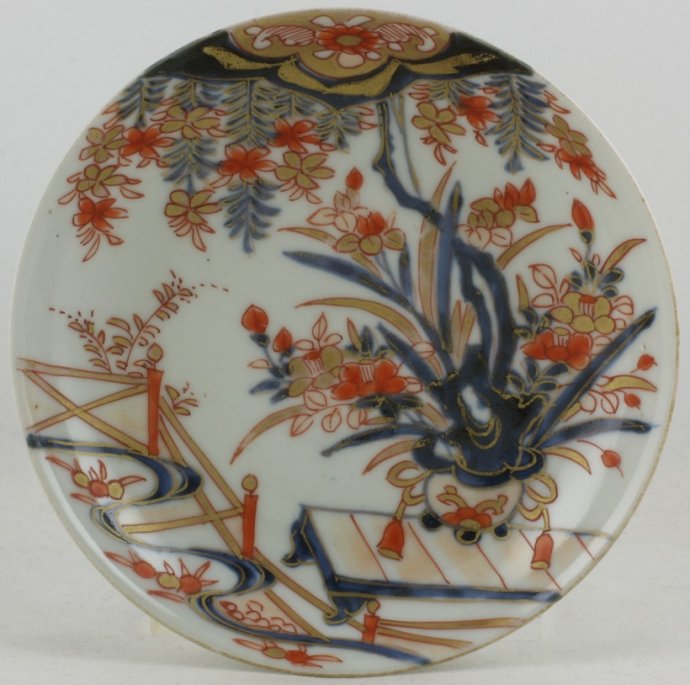
Sold Ceramics - Sold Japanese Tea, Coffee and Chocolate wares 18th Century - Page 2
Object 2012626
Saucer
Japan
c.1700
Height 23 mm (0.91 inch), diameter of rim 112 mm (4.41 inch), diameter of footring 47 mm (1.85 inch), weight 77 grams (2.72 ounce (oz.))
Saucer on footring, slightly spreading rim. Imari decorated in underglaze blue, overglaze iron-red and gold with an all-over design of a shaped jardiniere filled with a rock, flowering iris and camellia. The pot has a ribbon and a tassel on each side and stands on a long table near a fence and a swirl of water. Above the pot a single large ruyi-motif filled with a simplified flower and leaves on a gold ground; below the motif pendent wisteria and prunus. The reverse is undecorated.
The well-executed design is a good example of the painter's eclectic approach. He combined common motifs such as the flowerpot, the fence, the ruyi-design and the pendent flowers without attempting to depict a realistic and coherent scene, intent only on making a pleasant decoration and composition. (Jörg 1989/2, p.200, cat. 254)
For an identically shaped, sized and decorated teacup and saucer, please see:
In his description of this identically shaped, sized and decorated teacup and saucer Jörg notes 'No comparable tea wares seem to be known'.
Condition: Some glaze firing flaws to the reverse rim.
Reference:
Price: Sold.
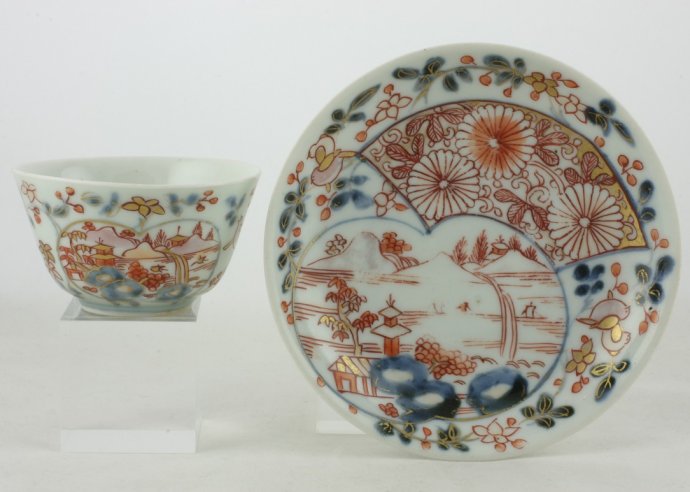
Sold Ceramics - Sold Japanese Tea, Coffee and Chocolate wares 18th Century - Page 2
Object 2010297
Teacup and saucer
Japan
1700-1730
Height of teacup 42 mm (1.65 inch), diameter of rim 72 mm (2.83 inch), diameter of footring 31 mm (1.22 inch), weight 42 grams (1.48 ounce (oz.))
Height of saucer 22 mm (0.47 inch), diameter of rim 120 mm (3.72 inch), diameter of footring 62 mm (2.44 inch), weight 87 grams (3.07 ounce (oz.)
Teacup and saucer on footrings with spreading sides and rims. Imari decorated in underglaze blue with overglaze iron-red and gold with two medallions, one fan-shaped filled with chrysanthemums flower heads on a leafy ground, the other kidney-shaped filled with a riverscape with houses, trees, mountains and a waterfall. On the rim four birds perched on flowering branches. The teacup is decorated en suite.
The decoration on this teacup and saucer is a good example of Japanese taste to be found in the asymmetry of the decoration.
Condition: Both perfect.
Price: Sold.

Sold Ceramics - Sold Japanese Tea, Coffee and Chocolate wares 18th Century - Page 2
Object 2010101
Teacup and saucer
Japan
1700-1730
Height of teacup 35 mm (1.38 inch), diameter of rim 60 mm (2.36 inch), diameter of footring 25 mm (0.98 inch), weight 30 grams (1.06 ounce (oz.))
Height of saucer 19 mm (0.75 inch), diameter of rim 98 mm (3.86 inch), diameter of footring 45 mm (1.77 inch), weight 56 grams (1.98 ounce (oz.))
Teacup and saucer on footrings with spreading sides and rims. Imari decorated in underglaze blue with overglaze iron-red and gold with a single chrysanthemum flower spray in a central roundel. On the sides and rim three medallions filled with a riverscape reserved on leafy ground in iron-red and gold. The teacup is decorated en suite.
Condition: Both perfect.
Price: Sold.
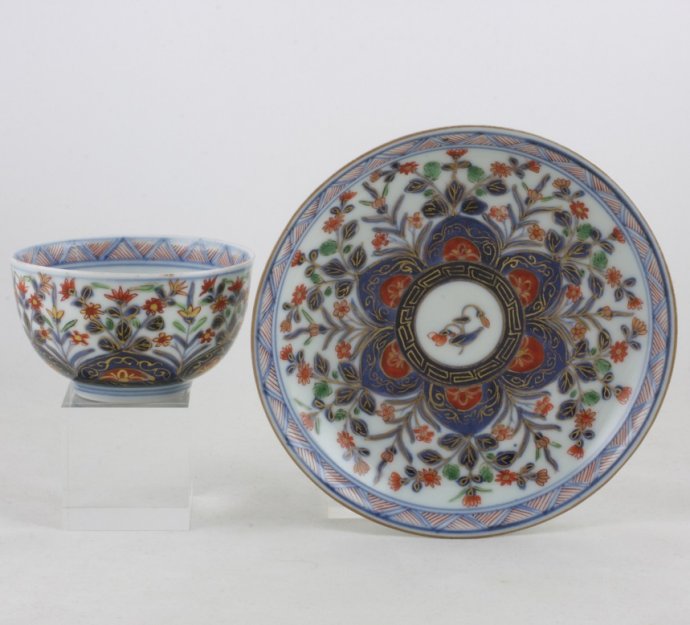
Sold Ceramics - Sold Japanese Tea, Coffee and Chocolate wares 18th Century - Page 2
Object 2012127
Teacup and saucer
Japan
1700-1730
Height of teacup 45 mm (1.77 inch), diameter of rim 75 mm (2.95 inch), diameter of footring 33 mm (1.30 inch), weight 51 grams (1.80 ounce (oz.))
Height of saucer 22 mm (0.83 inch), diameter of rim 128 mm (4.69 inch), diameter of footring 68 mm (2.72 inch), weight 101 grams (3.56 ounce (oz.))
Teacup and saucer on footrings, slightly everted rims. The saucer with a spur-mark on the base. Imari decorated in underglaze blue, iron-red, green, black and gold with a central flower spray surround by an underglaze blue band with a meander pattern in gold and six lotus leaf-shaped panels in underglaze blue with foliate scrolls in gold filled with a flower head in gold on an iron-red ground. On the sides various flowering plants. On the rim a zig-zag lines-pattern border. On the reverse three flower sprays and on the base a single concentric band in underglaze blue. The teacup is decorated en suite.
The decorative style on this teacup and saucer is very similar to that used on other, earlier sold, Japanese Imari tea ware. The translucent enamel colours, the zig-zag lines-pattern borders and the reverses with the three wide spread flower sprays are all very similar. This could indicate that these may be the product of a single workshop but may or may not be the product of a single kiln, specialised in these high-quality tea wares. Judging by Dutch 18th century sales and inventories, Japanese porcelain was quite expensive at the time and even more highly valued than its Chinese counterpart.
The decoration on this teacup and saucer suggests that it could have been made for the Indian market. An identically shaped, sized and decorated set is in an English private collection.
For, earlier sold, Japanese tea wares decorated in this similar style, please see:
Sold object 2010334 (not included in this sale/offer)
Sold object 2010334 (not included in this sale/offer)
Sold object 2012088 (not included in this sale/offer)
Sold object 2012088 (not included in this sale/offer)
Sold object 2010609 (not included in this sale/offer)
Sold object 2010100L (not included in this sale/offer)
Sold object 2010100L (not included in this sale/offer)
Sold object 2011995 (not included in this sale/offer)
Sold object 2011995 (not included in this sale/offer)
Condition:
Teacup: Perfect.
Saucer: Perfect.
Reference:
Price: Sold.

Sold Ceramics - Sold Japanese Tea, Coffee and Chocolate wares 18th Century - Page 2
Object 2012231
Saucer
Japan
1700-1720
Height 25 mm (0.98 inch), diameter of rim 122 mm (4.80 inch), diameter of footring 59 mm (2.32 inch), weight 92 grams (3.25 ounce (oz.))
Saucer on footring, straight rim with a slightly everted edge. Imari decorated in underglaze blue, iron-red, black, gold and various other overglaze enamels, with in the foreground a spit of land with a man on a bridge, rocks at right, trees and a pavilion. To the left of this chickens behind a fence, three standing figures and another figure in a small house. In the background hills with a pagoda and a pavilion. On the rim a zig-zag lines-pattern border and on the reverse three groups of flower sprays.
The design on this Japanese saucer was taken as an example to be used on a Dutch over-decorated dish in the Jan Menze van Diepen collection (JMVD-P-1037). On this dish the Dutch artist did his best to recreate a Chinese scene, incorporating many elements of Oriental porcelain. These include the motif of the man with a carry-pole on his shoulder, the composition of the landscape, the out-of-perspective pavilion at right and the way the spit of land is depicted. Moreover, some elements of the original were not well understood, such as the rocks at the right, which look more like clouds. The painter combined all these elements in a Western way, thereby creating a Chinoiserie. (Jörg 2002/2, p.156, cat. 109)
(Dish reproduced from: Jan Menze van Diepen Stichting. Selectie uit de collectie Oosterse keramiek. (Jan Menze van Diepen Foundation. A Selection from the Collection of Oriental Ceramics), (C.J.A. Jörg, Slochteren, 2002), p.156, cat. 109 this dish is not included in this sale/offer)
The decorative style on this saucer is very similar to that used on other, earlier sold, Japanese Imari tea ware. The translucent enamel colours, the zig-zag lines-pattern borders and the reverses with the three widespread flower sprays are all very similar. This could indicate that these may be the product of a single workshop but may or may not be the product of a single kiln, specialised in these high-quality tea wares. Judging by Dutch 18th century sales and inventories, Japanese porcelain was quite expensive at the time and even more highly valued than its Chinese counterpart.
For, earlier sold, Japanese tea wares decorated in this similar style, please see:
- Sold Ceramics - Sold Japanese Tea, Coffee and Chocolate wares 18th Century - Page 1 - Objects 2010334 and 2011366.
-
Sold Ceramics - Sold Japanese wares with Western Designs 1653-1800 - Object 2012088.
-
Sold Ceramics - Sold Japanese wares with Western Designs 1653-1800 - Object 2010609.
Condition: A filled hole in the centre.
References:
Jan Menze van Diepen Collection of Oriental Ceramcis object: JMVD-P-1037
Price: Sold.

Sold Ceramics - Sold Japanese Tea, Coffee and Chocolate wares 18th Century - Page 2
Object 2012158
Saucer
Japan
1700 -1720
Height 22 mm (0.87 inch), diameter of rim 126 mm (4.96 inch), diameter of footring 50 mm (1.97 inch), weight 81 grams (3.07 ounce (oz.))
Saucer on footring, wide flat rim. Imari decorated in underglaze blue, iron-red, overglaze green, yellow and black enamel and gold with a central flower spray surrounded by knotted ribbons with intertwined tassels. On the rim groups of various flowering plants alternating with a bird in flight. On the reverse a continuous floral scroll.
Condition: Perfect.
Price: Sold.
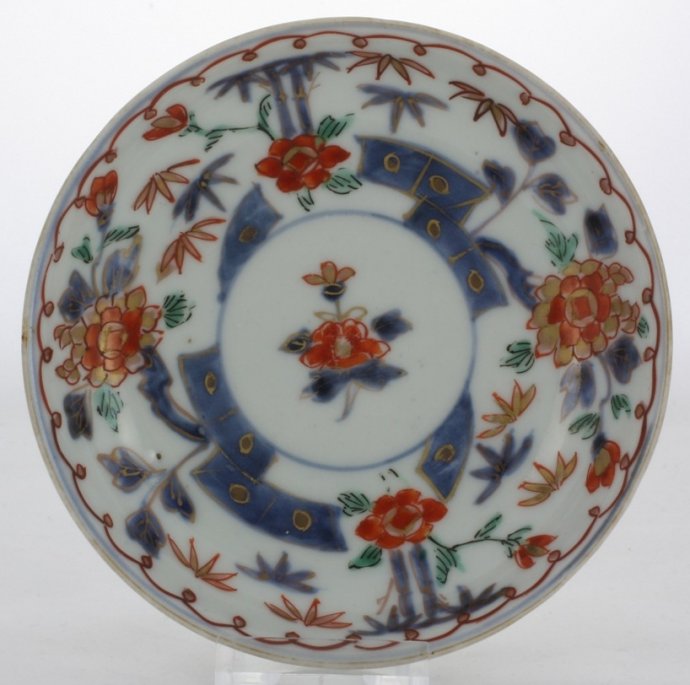
Sold Ceramics - Sold Japanese Tea, Coffee and Chocolate wares 18th Century - Page 2
Object 2010384
Saucer
Japan
1700-1730
Height 26 mm (1.02 inch), diameter of rim 125 mm (4.92 inch), diameter of footring 68 mm (2.68 inch), weight 131 grams (4.62 ounce (oz.))
Saucer on footring, straight rim. Imari decorated in underglaze blue with overglaze iron-red, black and green overglaze enamel and gold with a peony flower spray in a central roundel, on the sides flowering peony and bamboo plants growing from rockwork. On the rim a spiral pattern border. On the base a shop or painters mark in underglaze blue. The reverse is undecorated.
Condition: Two firing flaws.
Price: Sold.
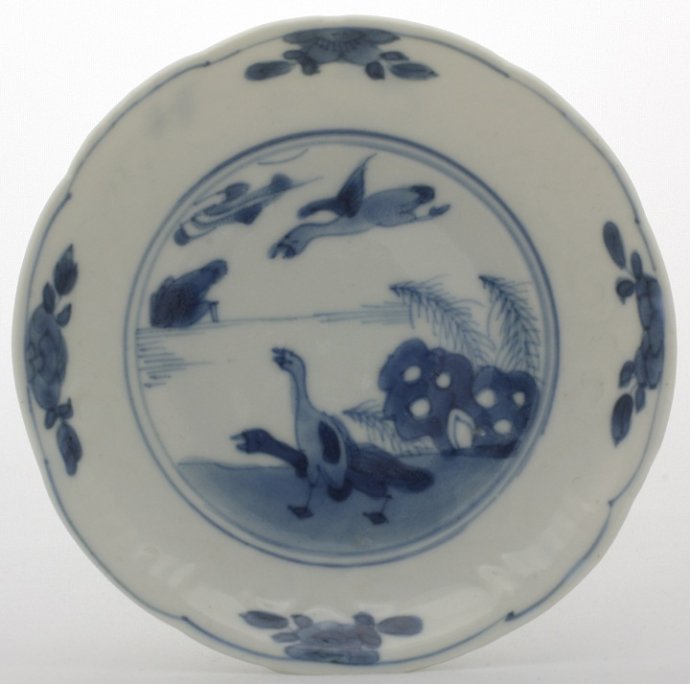
Sold Ceramics - Sold Japanese Tea, Coffee and Chocolate wares 18th Century - Page 2
Object 2011293
Saucer
Japan
c.1750
Height 20 mm (0.79 inch), diameter of rim 110 mm (4.33 inch), diameter of footring 52 mm (2.05 inch), weight 60 grams (2.12 ounce (oz.))
Moulded saucer on footring ,straight rim with scalloped edge. Decorated in underglaze blue with four ducks, two near a shore one in flight and one in a pond with its head under water. On the sides and rim four groups with half flower heads on a moulded floral decoration. On the reverse two flower sprays.
Condition: Perfect.
Price: Sold.



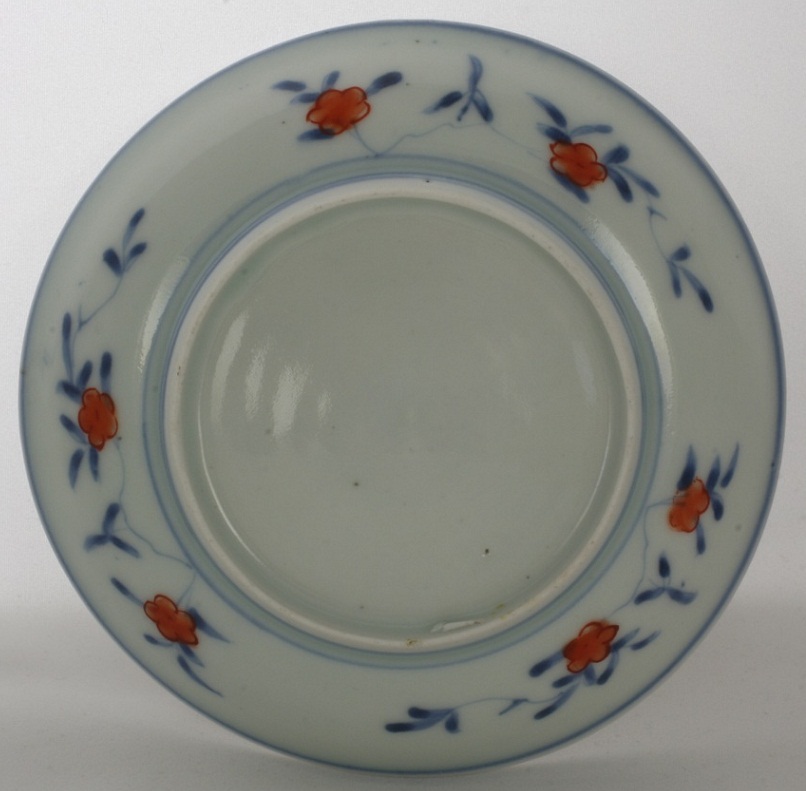



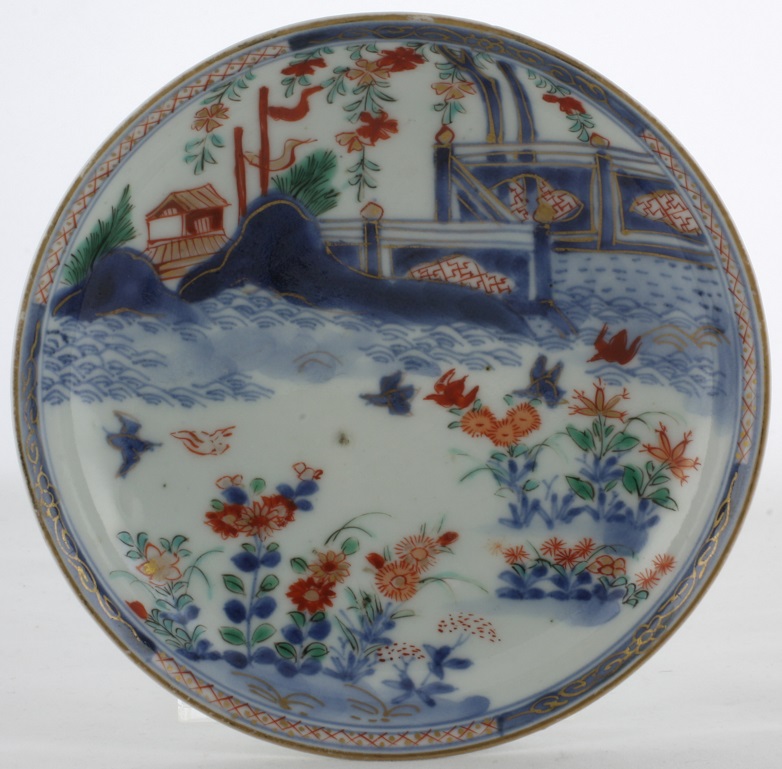
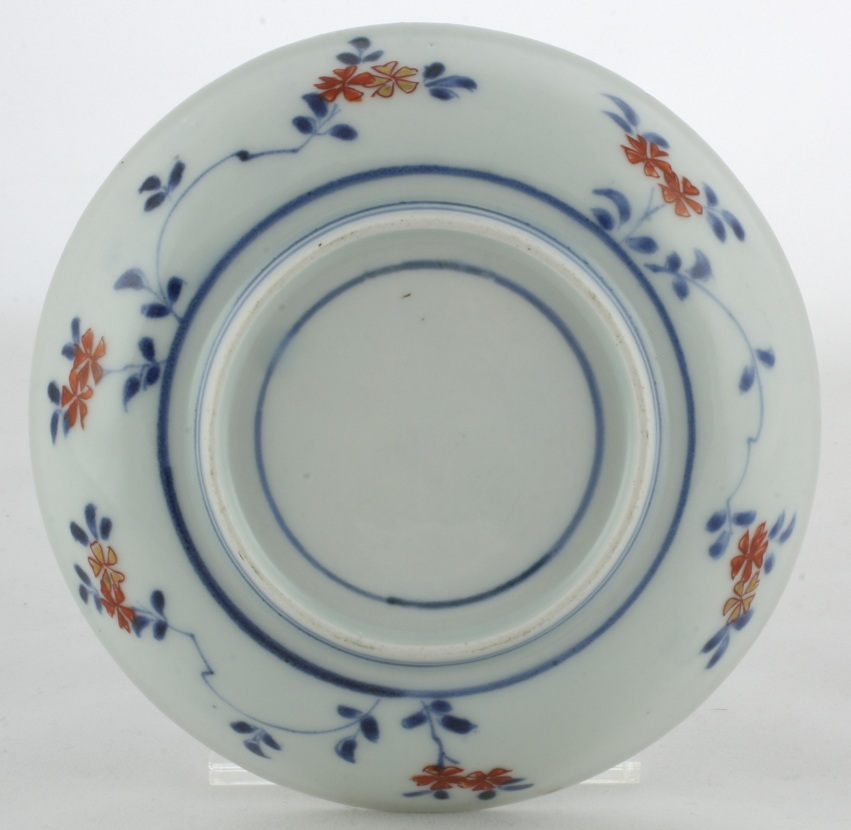


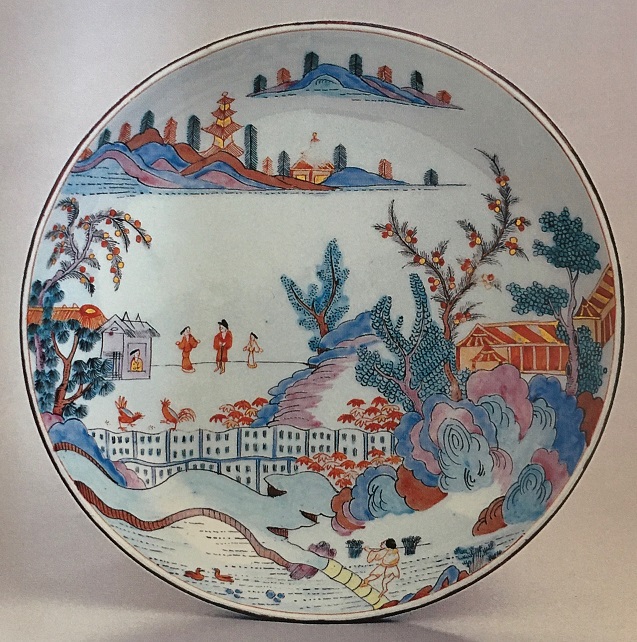
 create websites
create websites